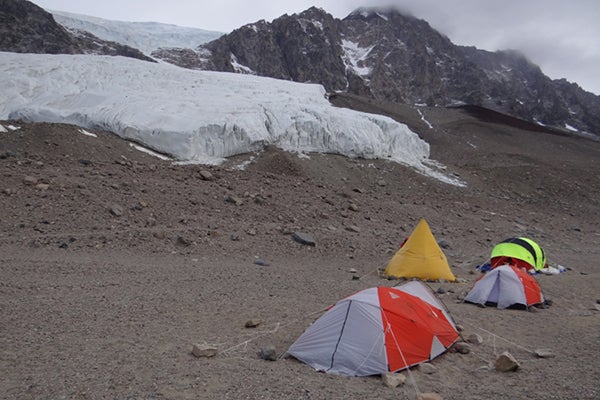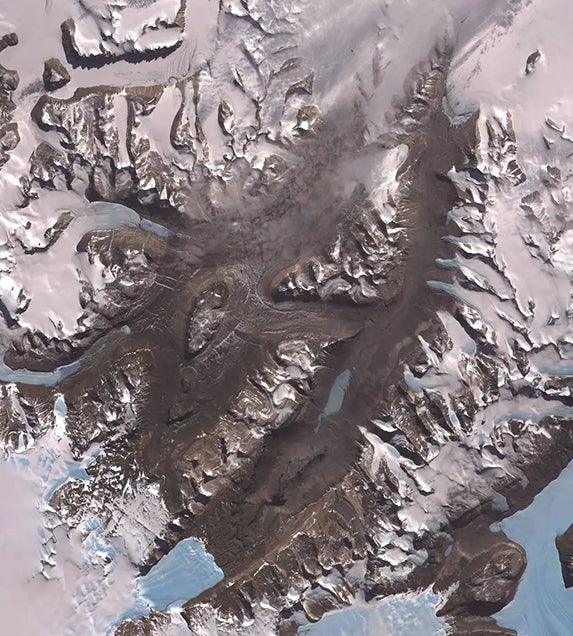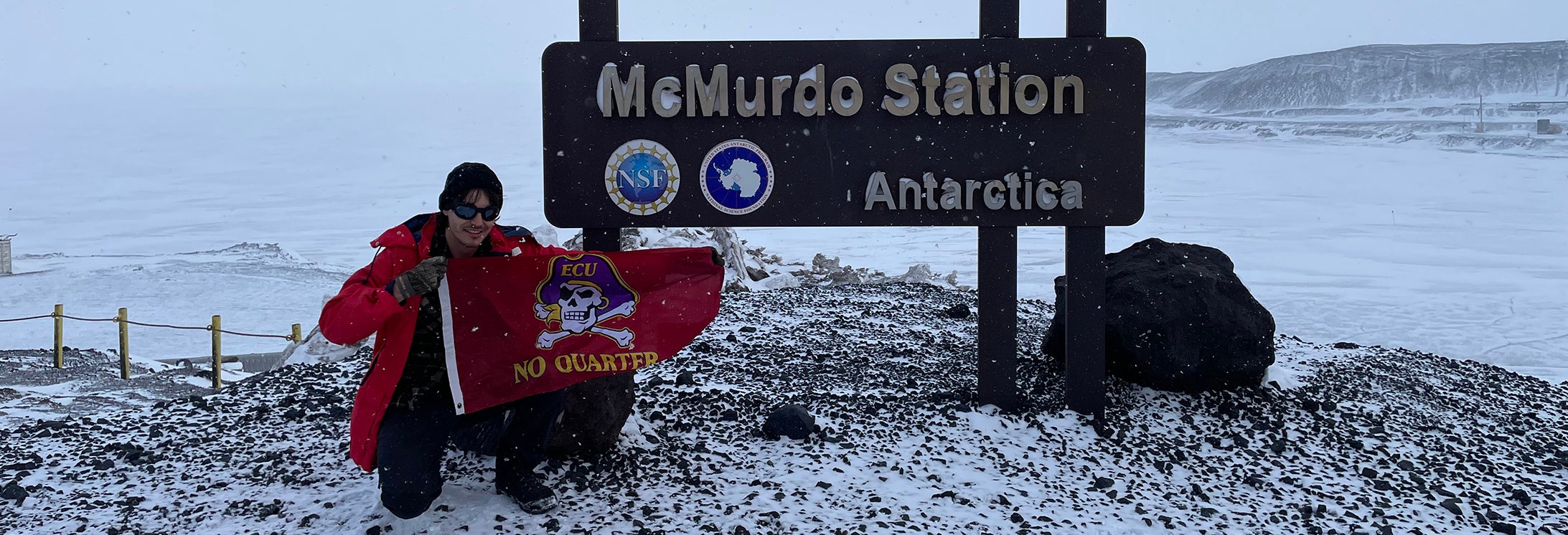ECU Researchers Record Glacial Melt in Antarctica
Researchers from East Carolina University are studying glacial melt at the Antarctic to better understand the impact of climate change in the polar region around the Earth’s south pole.
Tristan Bench, an ECU postdoctoral researcher working with Dr. Regina DeWitt, a professor in the Department of Physics, spent 40 days at the U.S. National Science Foundation McMurdo Station in Antarctica from November through early January. Bench said the camp setup was simple, with just a few personal tents and a storage tent with canned, dehydrated, powdered and frozen foods that could be easily cooked with a small portable stove.
“The simple camping arrangements were necessary as we changed campsites several times during our stay on the continent,” Bench said. “We had to be able to quickly pack our camping supplies into a helicopter sling, then quickly set the camp up again when the helicopters dropped us off at our site.”

Bench camped at LaCroix Glacier in the Taylor Valley of the Dry Valleys region of Antarctica. (Contributed photo)
Bench and DeWitt are attempting to record glacial melt fluctuations in the Antarctic to understand the impact of past regional climate fluctuations on Antarctic landscapes. This information can serve as a useful reference for current glacial melting events and help better determine future scenarios under a changing climate.
“These improved assessments are useful for predicting, for instance, flood risks of communities that live near glaciers, or for understanding how climate fluctuations could impact the accessibility of freshwater sources supplied by glacial melt,” Bench said.
Bench’s participation in this Antarctic research resulted from his 10 years of academic interest in Earth surface processes. As an undergraduate geology major, Bench volunteered in labs that worked to determine the age of rocks and minerals. After graduating, he held a position as a field technician installing environmental monitoring equipment but he decided to enroll in graduate school to research methods for calculating rock surface exposure ages using luminescence, to date glacial erratic rock deposits and configure glacial retreat responses to past climate change events. After graduating with his doctoral degree, the expertise he acquired from his research made him a good candidate for luminescence dating research in Antarctica.
Before setting out in the field, Bench participated in field training sessions. The lessons covered field safety, including how to set up a campsite to withstand very inclement and unpredictable weather patterns, and ways to detect and prevent hypothermia and frostbite. He also learned how to operate a ham-style radio in case he was ever out of range of the McMurdo Station’s general radio.
Bench spent his time at Dry Valleys, about an hour-long helicopter ride from the McMurdo Station, and the only location in Antarctica without continuous snow cover. Rather than snow and ice, the valley surfaces contain sediment and rock deposited from past glacial and hydrological activities. The lack of ice and snow is largely due to limited precipitation in the region, which generally amounts to less than four inches of snowfall per year.
“The Dry Valleys is considerably warm for Antarctic standards, with December and January often hosting many days above freezing, which allows for glaciers to melt and streams to flow during this period,” he said.
Bench said the typical day was between 20 and 30 degrees Fahrenheit and sunny but usually with a persistent, icy wind of about 20 miles an hour.
“It was the kind of weather where you did not want any skin exposed to the elements,” he said. “Days with no wind were very rare and treasured, as you didn’t have to cover every square inch of your body to feel comfortable.”
In addition to the colder temperatures and wind, the sun also never set while Bench was in Antarctica.
“We were out in the field New Year’s Day and the sun was completely out when the clock struck midnight,” he said. “We were some of the first people in the world to see the sun in the new year.”

The McMurdo Dry Valleys are a row of valleys west of McMurdo Sound, Antarctica, so named because of their extremely low humidity and lack of snow and ice cover. (Photo contributed by NASA.)
Bench sampled alluvial fans from several of the valleys, which are sediment deposits that develop at the end of streams and rivers. The fans he sampled were created from glacial meltwater streams, and the deposits in the fans can be attributed to periods when there was significant glacial melt. He said that when compared to past climatic information of the region, the data offers insight on how glaciers responded to past climate change and highlights the sequential significance of its impact on the landscape.
“The sparseness of the Dry Valleys makes it a great place to conduct climate response research, in that there are very few ecological impacts to consider in evaluating environmental response,” Bench said. “For instance, the only living organisms in the valleys that can survive the harsh climate consist of algae, bacteria, tardigrades and nematodes. As such, in the valleys, one can observe the long-term effects of river morphology and lake level changes from glacial melt events without having to consider plants or animals impacting the development of the river. Such a well-constrained environment is very rare, yet very helpful for evaluating environmental effects from such a complex circumstance like climate change.”
The age of accumulation for alluvial fan sediments is determined using optically stimulated luminescence. This method calculates the burial age of sediments by measuring the environmental radiation they absorbed since their last light exposure. The process involves quantifying ultraviolet emissions, or luminescence, from quartz grains in the sediment when exposed to visible light. Over time, luminescence builds up in the quartz due to radiation exposure, which can be correlated to an environmental dose rate. To preserve this record, samples must remain shielded from light after burial, as light exposure erases the stored radiation dose. When sampling the sediment, Bench used light-proof tarps laid over the sample pits to prevent any light from interacting with the sediment.
Bench said this experience provided him useful insights into how to plan and lead future environmental research projects either in academic or industry settings.
“In particular, the fieldwork offered great perspectives for handling group management in severe field settings like the Antarctic climate,” he said.
Now back from Antarctica, Bench will lead the luminescence dating analysis for the project, gaining valuable experiences in managing the analytical aspects of the research and receiving direct critical feedback from the peer-reviewed scientific community — “both of which are essential for developing proficiency as a scientist,” he said. After completing his postdoctoral research, Bench hopes to lead more publicly funded environmental research projects that apply luminescence dating procedures to understand Earth surface processes.
